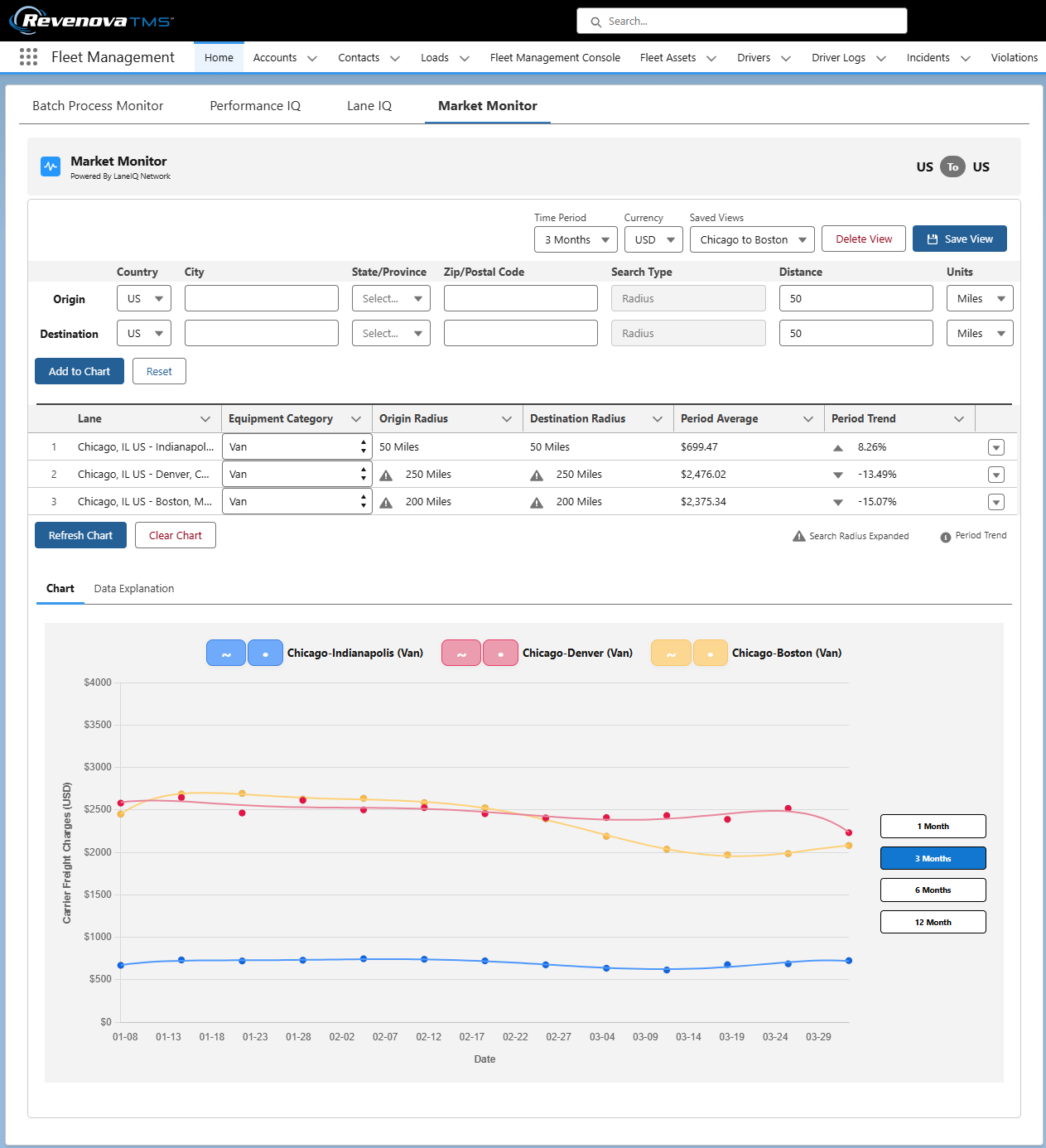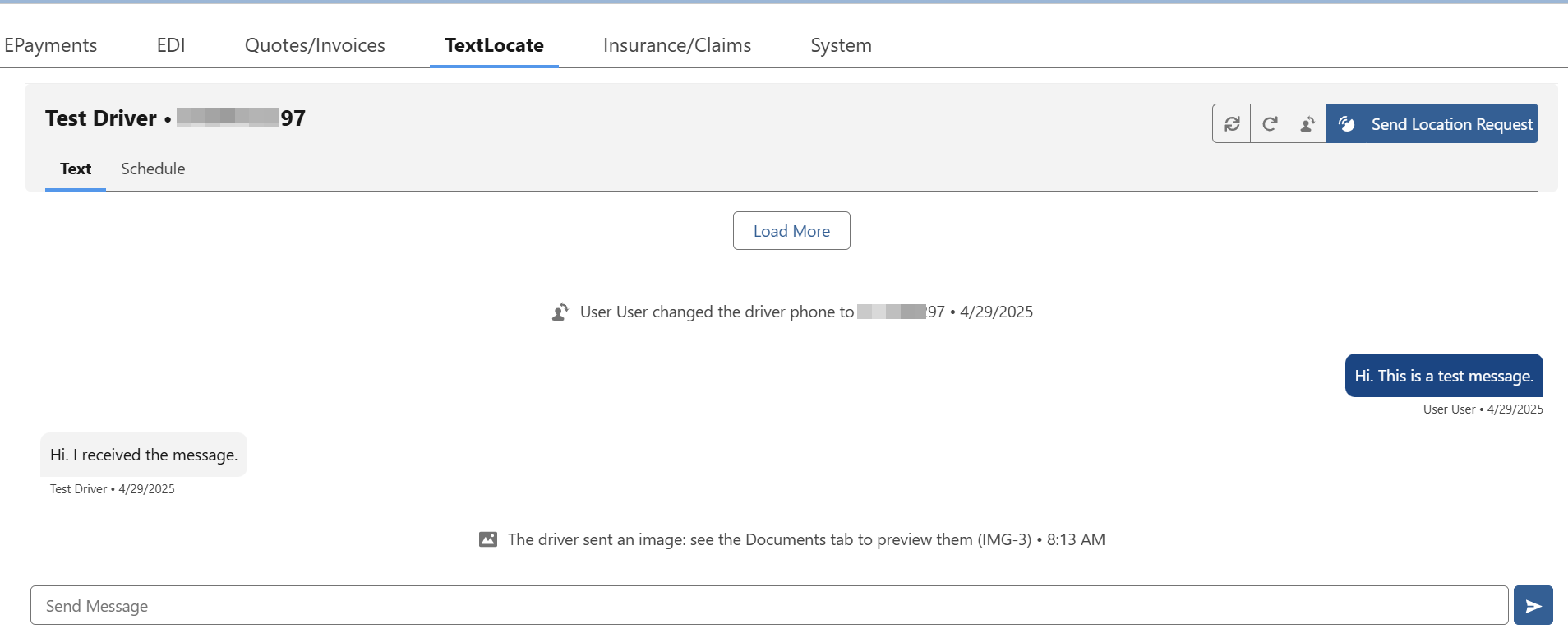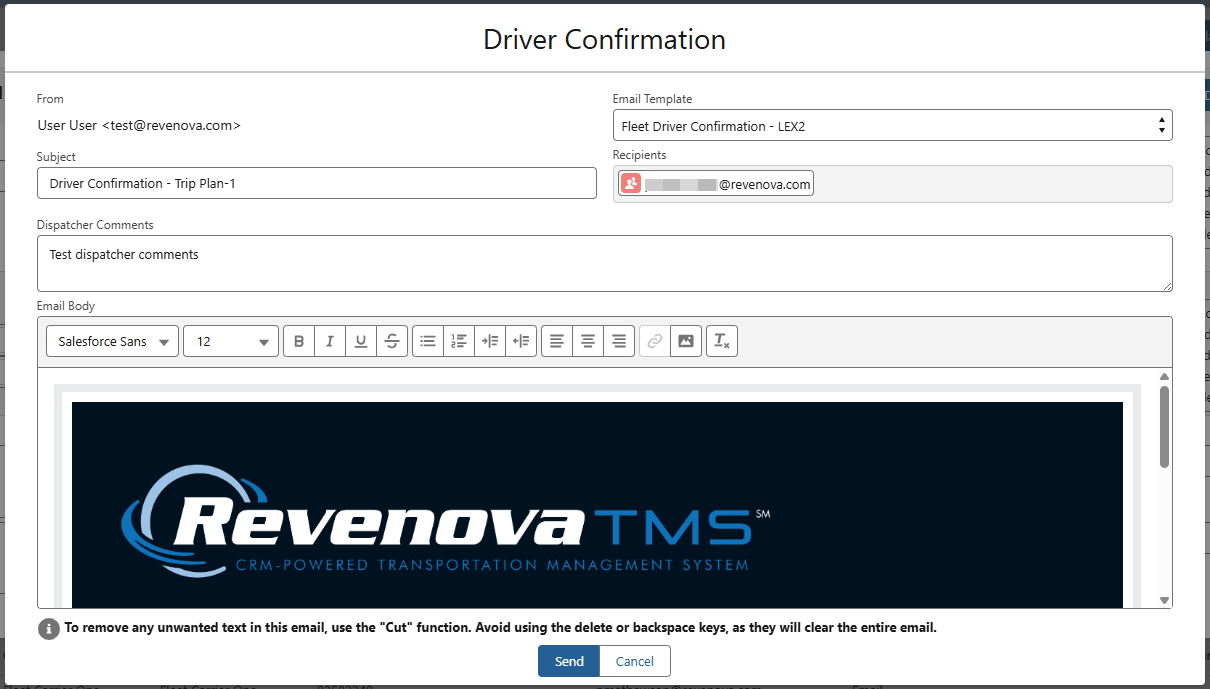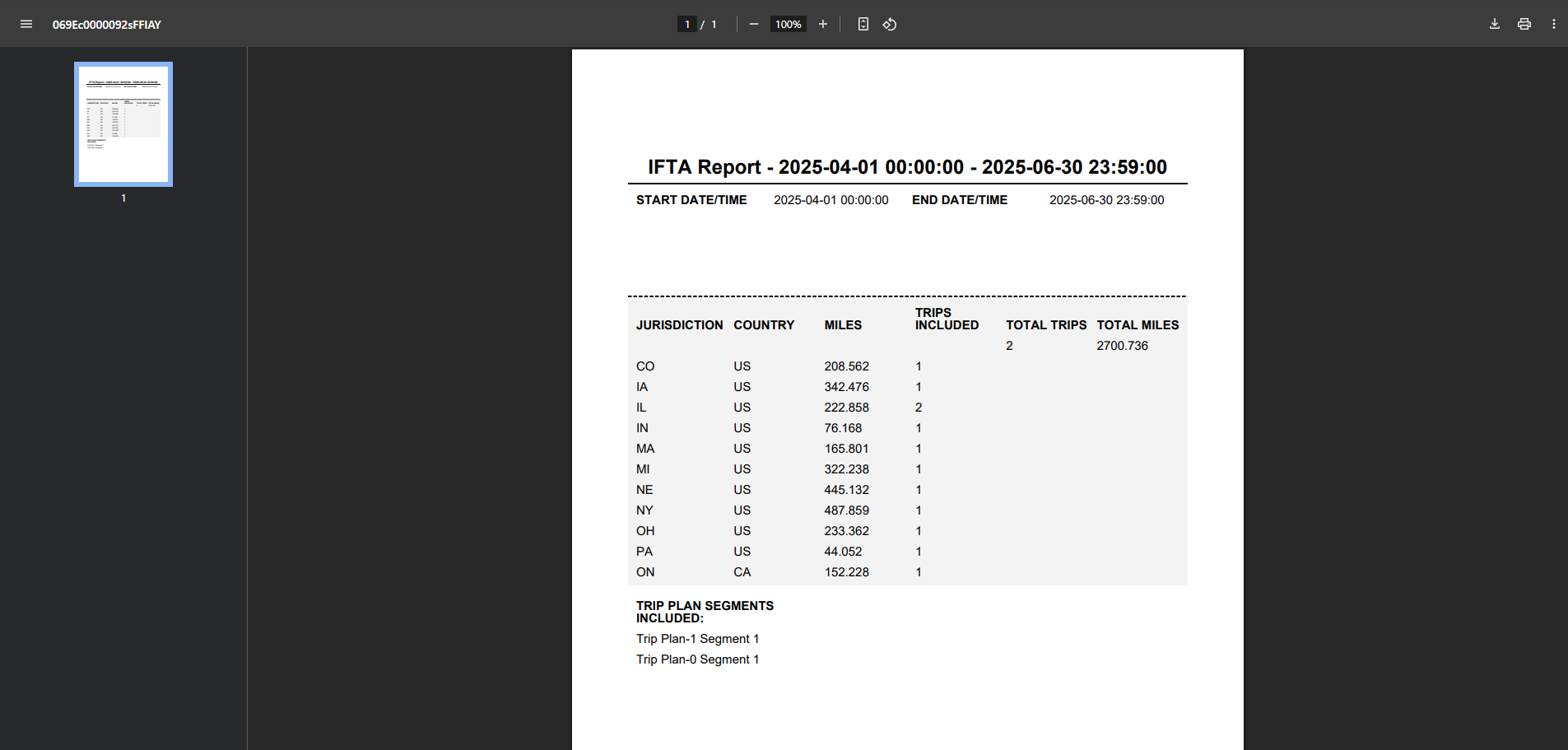Spring ‘25 Release Enhancements
Brokerage Enhancements
EDI Enhancements for Rail Logistics
Coordinate with your EDI VAN to confirm they have implemented the latest version of the Revenova EDI Specification. The VANs must be on the latest version even if not using the Rail functionality.
The Revenova TMS now supports the following EDI transactions to expand support for rail logistics. Create Rail Loads using the Freight Plan Console to create a Freight Plan with one customer Load to multiple Carrier Loads. Typically a Rail Freight Plan consists of one Drayage Carrier Load, one Rail Carrier Load, and one Drayage Carrier Load.
404 (Rail Carrier Shipment Information)
322 (Terminal Operations and Intermodal Ramp Activity)
998 (Set Cancellation)
410 (Rail Carrier Freight Details and Invoice Specifications)
824 (Application Advice)
See the EDI Specification guide for more EDI transaction information.
Rate Entry and Quoting Logs
The API Quote Audit Log component allows for reviewing when and why Carrier quotes are filtered out during the quoting process. This component saves time to more efficiently troubleshoot issues when receiving Carrier quotes from API partners.
.png)
The Load Match Test component allows for testing whether a specific Rate Entry and Load combination match. Users can diagnose and resolve mismatches.
.png)
MyCarrierPackets Integration Enhancements
The integration with MyCarrierPackets is enhanced to allow for more flexibility and additional data elements.

Easily send onboarding invitations to Carriers from the Onboard Carrier LWC. Receive an email notification when the Carrier has completed the onboarding packet.
Why it Helps
Additional Carrier information is automatically added to the TMS to more efficiently conduct business.
Bank Account
Carrier Equipment Types and Counts
Remittance Contacts
Web Service Performance Enhancements
We’ve enhanced our web service for load creation and quoting to deliver better performance, reliability, and faster response times.
For the TMSLoadService.createLoad, we've optimized the Load save logic, resulting in significantly quicker processing.
In the TMSQuoteService, we've streamlined quote retrieval by running each LTL API callout on an individual thread, enabling parallel processing for a notable speed boost. And the best part? If you're satisfied with the current performance, rest assured that these improvements are fully backward compatible!
See the Revenova Web Services Guide for more information.
Market Monitor
The Market Monitor plugs users into key insights on capacity trends from Revenova’s LaneIQ Network database. Gain real, up-to-date market insights from quote data pulled from Revenova customers just like you. Track macro-trends in market prices over long stretches or focus in on recent changes that might impact your business. Plot similar lanes side-by-side to compare trends and target areas of opportunity.

Give your users added perspective for Load quoting. Market Monitor plots important trends in the market for your Loads. Put your Load in perspective with insights into the changing costs for each lane.
.png)
Automatic Tracking Updates
The automatic carrier tracking feature is designed to remove manual steps from the track and trace process of moving a Load. By capturing tracking settings like preferred provider, desired start time, and more at the Customer Transportation Profile level, users can set up tracking automation based on each customer’s business. When combined with other TMS automation features, automatic tracking further removes users from operational tasks and allows them to focus on managing exceptions and driving customer satisfaction.
The Automatic Carrier Tracking feature automatically sends the start tracking request via API to the selected tracking provider when the Load status is assigned and the specified start time is reached.
Using our Transportation Profile ‘global cascade,’ users don’t need to set up each customer individually. Instead, set all Transportation Profiles to look at the settings on the global TP with just a few clicks.
The Queued Transaction Job must be running in order for this feature to work. The Queued Transaction sends the start tracking request and must be running.

See the Automatic Load Tracking section on the Carrier Banner for more information.
![]()
In the Spring ‘25 release, the tracking process is enhanced to record whether Carriers have accepted tracking sessions. In building this feature, we worked directly with our tracking provider partners to understand how they capture this information today. As a result, customers can use tracking acceptance to create reports on Carrier tracking compliance and to drive exception management procedures.
TextLocate Integration
TextLocate provides our customers with additional ability to communicate via text with Drivers directly from Revenova. Drivers can provide text messages, location updates, and images for the Loads to/from Revenova. The features of TextLocate provide the ability to do the following.

No app install required. TextLocate only requires a Driver’s phone number and name.
MacroPoint and Trucker Tools require an app and require sharing your location at all times. Additionally, Drivers have to share their location through the browser on their phone.
The integration allows for completing the following tasks.
Send and receive text messages to and from Drivers.
Schedule text messages or location requests.
Monitor text messages to know if they are received.
Automatically request a POD once a Load is delivered.
Request Driver locations and receive their current location in return with a location request text message that includes a link to share the update.
Receive images and documents from Drivers.
Use the integration with TextLocate as a stand alone tracking provider on a Load or in conjunction with MacroPoint or Trucker Tools. (Use TextLocate to send a text / communicate instead of a check call) on Loads.
Display Load Board to Carriers
A new Load Board in the Carrier Guest LWC provides Carriers the ability to view other available Loads.
Carriers may search for other available Loads based on Pickup and Dropoff locations, Ship and Delivery Dates, Mode, and Weight.
Why it Helps
The Load Board is free and may be used without a license and is automatically populated after accepts your Load tender. Carriers may view and bid on Loads you’ve elected to expose from your org.
.png)
Carriers are able to submit quotes for available Loads. The Load Board respects both Accessorial and Carrier Exclusions, as well.
.png)
Fleet Enhancements
Catena (formerly Axle) ELD Integration
Easily keep track of documents and correspondence between Fleet staff.
The integration with Catena (formerly Axle) is enhanced to support documents and messages. Documents are sent through Catena and are stored on the affiliated Load record. If no Load is associated with the document, an Inbound Email record is created to store in the TMS.
Send to and receive messages from Drivers in your Fleet.

Messages are are sent from the following locations.
From an individual Load on the Load Detail LWC.
From the Fleet Management Console view by selecting Driver(s).
From the Trip Plan Segment for an individual Trip Plan.
Messages are stored on the Driver Chatter feed for easy reference.
Messages and Documents are only supported for the ELD Providers able to provide them. Not all ELD Providers available through Catena may support messages and/or documents.
Trip Planning Enhancements
Many enhancements and quality of life improvements are added to the Trip Planner LWC to optimize planning Fleet trips.
Stops are displayed with a P or D to indicate the Stop type in Trip Plan Legs.
View Load line item information directly on the Trip Planner LWC.
Driver Hours of Service information is available when planning Trips.
Select the distance units per-user to view Trip information in the preferred distance units.
View Loads on the Calendar in the Fleet Management Console.
Automatically include the Power Unit/Tractor when adding Drivers to a Trip Plan.
Other UI enhancements to more efficiently create Trip Plans.
Driver Confirmation Comments
Enhancements to the Driver Confirmation workflow allow for clearer communication between the dispatcher and driver. These changes not only make the process easier, they also provide more opportunity to report on issues and identify areas for improvement.

Dispatchers may add notes to the Driver Confirmation email.
Drivers may add notes and a decline reason from the confirmation email.
IFTA Fuel and State Reporting
Create, retain, and export mileage and fuel data for IFTA state mileage reporting and audits. Create reports for specific date ranges or by quarter.
.png)
The Fleet Management Module provides the ability to create reports of state mileage and fuel data.
Reports are available for download for auditing purposes and can include each Trip Plan Segment.

Miscellaneous Enhancements
Enhancements to the architecture for the Lane Upsert and Load Posting triggers. Thoroughly test that any custom code based on these triggers is working properly when updating to the Spring ‘25 release.
Corrected an issue when attempting to cancel out of the Quick Carrier Review. Users are returned to the previous page when clicking Cancel.
The file/document uploader was enhanced to allow for file uploads of up to 2 gigabytes in size.
Several enhancements to the Load Tracking Log provide additional functionality and more accurate Load tracking.
Manually entering Stop details with Date/Time fields and Last Reported City/State fields displays the new fields. Previously, the Stop fields were displayed.
Customer Portal users are able to view tracking information for their customer Loads in a Freight Plan.
The Last Tracking Update Date/Time field updates more accurately from updates submitted in the Carrier Guest LWC.
The Load History Viewer LWC is enhanced to better support standard Salesforce fields. Specifically, changing the Owner field for a Load did not display correctly in the Viewer. Additionally, support for the Salesforce Approval Process is added to prevent an issue where the Lock/Unlock history did not display correctly.
Improved handling and support for merge fields (fields that span to another related object) in banner LWCs such as the Customer, Carrier, and Load banners.
The Revenova Banner LWC may be added to any record detail page. Configure the component to display field sets as necessary.
The Transportation Fees section properly displays on customer invoices for Ocean FCL Loads.
The Payable flag was added to the EPayment page layout and list view to support accessorial pay in the PayIQ package.
Enhancements to the Customer Portal allow users to see additional information in the Tracking Log.
An issue was corrected to properly create Lanes when uploading Rate Entries from the RFP Banner.
Document options logic more accurately controls masked rate confirmation email attachments when Assigning or Tendering a Load to a Carrier.
Enhancement to the Mass Import credential feature to catch errors when uploading user credentials for the TransCore integration.
When the NMFC Class field is added to the Line Item TMS7 field set, the field correctly displays on the Load Configuration LWC.
The Datatable View Query Limit field on TMS Admin → Configuration allows for restricting the number of records returned when querying TMS records. Decrease this number to increase the rate at which records are returned.
The Load Posting LWC respects the field permissions for the Offer Rate and Max Pay Amount fields to prevent users from changing read-only field types.
Improved handling of asynchronous Platform Events to avoid reaching Salesforce limits when tracking Loads.
Carrier Quote Freight Charges and Line Haul amounts are calculated based on the rateApplication element returned from SMC3.
This functionality matches the calculations for generating customer quotes.